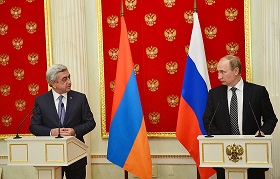A military parade rehearsal is always a big deal. Yet the media’s interest in a rehearsal that took place in Yerevan on September 16, 2016 was not caused by the fact that Armenia was about to celebrate the 25th anniversary of its independence. The Russian-made Iskander missiles were spotted in the streets of Yerevan that day. Armenia’s Iskanders have remained in the crosshairs of attention of journalists and analysts alike ever since.
A military parade rehearsal is always a big deal. Yet the media’s interest in a rehearsal that took place in Yerevan on September 16, 2016 was not caused by the fact that Armenia was about to celebrate the 25th anniversary of its independence. The Russian-made Iskander missiles were spotted in the streets of Yerevan that day. Armenia’s Iskanders have remained in the crosshairs of attention of journalists and analysts alike ever since.
There are many reasons for that. First of all, this is the first time the Iskander, a Russian-made operational tactical missile complex, was provided to the armed forces of a foreign state. Most likely though, this is an export version featuring a reduced range of 250–280 kilometers (instead of the standard 500). That said, this is more than enough for the Armenian armed forces given the configuration of the conflict in Nagorno-Karabakh. The special attention enjoyed by the supply of the Iskanders to Armenia is due to the so-called “four-day war”. Most likely, the Iskanders appeared in the Armenian army before April 2016: Rumours of their actual or anticipated presence there had been swirling since 2013; however, early reports showed that they would be delivered to Russia’s 102nd Base. Their display at the September parade was a step intended to confirm that Armenia indeed possessed the Iskanders, and thus to close the case.
No matter when exactly the Iskanders arrived to Armenia, the fact that Yerevan has them at all helps maintain a balance between the two sides of the Nagorno-Karabakh conflict. Recent years saw a lot of talk about how this balance had been tilted as Azerbaijan used oil revenues to build up its military potential. At the same time, Armenia was particularly appalled by the fact that Russia, Armenia’s strategic ally, was also the biggest supplier of arms to Azerbaijan. Whereas prior to 2016 Moscow was blamed for those supplies mainly by the media, the expert community or by civil activists, after the April events even Armenia’s president Serzh Sargsyan, known for his cautiousness in public pronouncements, raised the issue of the Russian arms supplies at a meeting with Russia’s PM Dmitry Medvedev.
Russian experts tend to explain the continuing arms supplies to Azerbaijan by, first of all, the fact that they are consistent with the objectives of Russia, which is interested in a partnership with Azerbaijan. Secondly, they are necessary to maintain a balance of power in the region. Yet the fact that the situation in Nagorno-Karabakh has been deteriorating over recent years has naturally concerned all interested parties, including Moscow. The flare-up of the Nagorno-Karabakh conflict in recent years is largely a result of Baku’s increased confidence in their military superiority. Apparently, the supply of the Iskanders to Armenia was intended to remind Azerbaijan that the conflict has no military solution, a mantra often repeated by its intermediaries.
This is important for Moscow, since any further escalation of the Nagorno-Karabakh conflict could lead to rather undesirable consequences. If the hostilities spread from the territory of the self-proclaimed Nagorno-Karabakh Republic into Armenian territory, Moscow will face a tough dilemma: Either to shrink from meeting its obligations as an ally, which would deal a harsh blow to the prestige of Russia and the CSTO, or to risk a conflict with Azerbaijan. That’s why, from Moscow’s standpoint, it is necessary to maintain a balance between the parties in order to avoid an aggravation of the conflict. What’s more, arms supplies to Armenia as well as initiatives such as the establishment of a joint Russian–Armenian military force not only help maintain a balance in the Nagorno-Karabakh conflict, but also bind Yerevan to Moscow with even closer ties and strengthen Moscow’s positions in Transcaucasia.
That the demonstration of the Iskanders led to less than positive reactions in Azerbaijan and Turkey was to be expected. Some experts in Georgia expressed some concerns over new Russia-sourced weapons, even though the official Tbilisi didn’t see any basis for preoccupation. The Western expert community noted the arrival of the Iskanders to Armenia too. Certain observers expressed concerns that this could lead to further arms race.
To what extent are such concerns justified? As a matter of fact, both Armenia and Azerbaijan have long faced the so-called security dilemma, where steps by either party to protect its security create a potential threat for the other party. And yet the supply of the Iskanders to Armenia as a step aimed at maintaining a balance will likely help restore a certain level of stability and predictability in the situation around Nagorno-Karabakh. In any case, despite the tough rhetoric coming from both sides and experts’ warnings of a possible repetition of the April events, the situation on the front line was relatively calm in the autumn.






